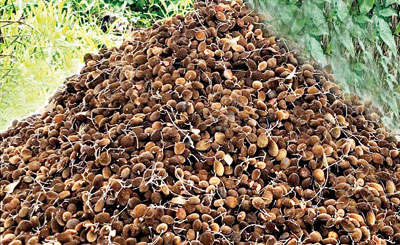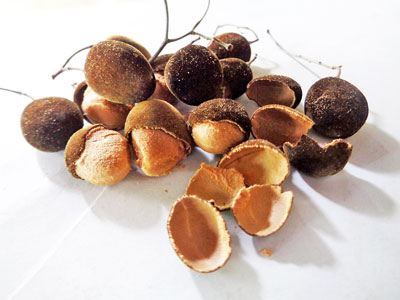That rare velvety marvel
 What a pleasant surprise it was to see a mound of the velvety marvel, gal siyambala at a makeshift stall by the roadside a few days ago. And no small wonder, so many were stopping by to buy some of this rare fruit that we see only just once every year usually between August and November. Those were the days, where we had heaps of gal siyambala at every school gate, at so many roadside stalls and at every pola or village fair. It was hard to miss the tiny pebble-like fruits. We used to get a paper cone what we called a gotta of gal siyambala for a few cents. Gone are those carefree days where our pockets were full of this sweet and sour tangy fruit whenever we could get it. These days, gal siyambala is sold by the gram at a much, much, higher price.
What a pleasant surprise it was to see a mound of the velvety marvel, gal siyambala at a makeshift stall by the roadside a few days ago. And no small wonder, so many were stopping by to buy some of this rare fruit that we see only just once every year usually between August and November. Those were the days, where we had heaps of gal siyambala at every school gate, at so many roadside stalls and at every pola or village fair. It was hard to miss the tiny pebble-like fruits. We used to get a paper cone what we called a gotta of gal siyambala for a few cents. Gone are those carefree days where our pockets were full of this sweet and sour tangy fruit whenever we could get it. These days, gal siyambala is sold by the gram at a much, much, higher price.
Gal siyambala that is scientifically identified as Dialium ovoideum in the family Leguminosae is endemic to Sri Lanka. It is known as kaduliem palam or kallu pullium in Tamil and velvet tamarind in English with the sophisticated name most probably originating due to the distinctive soft velvety feel of its brownish shell. The fruit itself is small, typically about 2cm long and about 1.5cm wide, cracks open easily revealing a light orange brown powdery pulp that encloses a hard flat round brown inedible seed coated with a thin layer of starch. It is definitely a nice feeling to split open the shell and take the brown pulpy button inside. The pulp is typically sucked or chewed and the seed thrown out.
 The fruits are borne on large shady trees that grow in the wild in the semi-dry regions in Sri Lanka such as the Moneragala, Ampara and Anuradhapura districts. The trees can reach a height of about 25m and may take even up to 20 years to reach maturity and bear fruits. They also have a very valued hard and compact wood and as gal siyambala is not grown on a commercial scale they are a threatened species. As the trees are tall, harvesting malpractices such as felling the tree or cutting large branches have led to mature trees becoming rare. This is extremely disappointing as different parts of the trees have been scientifically proven to have various health benefits.
The fruits are borne on large shady trees that grow in the wild in the semi-dry regions in Sri Lanka such as the Moneragala, Ampara and Anuradhapura districts. The trees can reach a height of about 25m and may take even up to 20 years to reach maturity and bear fruits. They also have a very valued hard and compact wood and as gal siyambala is not grown on a commercial scale they are a threatened species. As the trees are tall, harvesting malpractices such as felling the tree or cutting large branches have led to mature trees becoming rare. This is extremely disappointing as different parts of the trees have been scientifically proven to have various health benefits.
Tender gal siyambala leaves when squeezed and applied on wounds, stimulates the growth of healthy skin and protects the wounds against germs and moisture. A decoction of the leaves increases gastric mucous secretions and helps against gastric ulcers. The leaves are also highly diuretic promoting the production of urine reducing the risk of hypertension.The stem bark extract has significant analgesic property, hence can be used to reduce menstrual pain. The stem used as a chewing stick aids the removal of plaque and has a tooth cleaning effect, while a decoction of the bark is used to treat toothache.
This snack-like fruit, as we all know is great to eat on its own, but you will be surprised how it can be incorporated into your cooking. As the fruit is dry, it can be used in any recipe that uses dried fruits, so try adding the deseeded pulp into your cake mixture. Unlike other fruits, the pulp will melt and blend with the texture of the cake and you will not really notice any pieces until the sweet tangy subtle flavour of the fruity cake is felt on your tongue. So next time, amaze your family and friends with a velvet tamarind tea cake or cupcakes.
You can also make compote with the fruit. Boil the deseeded pulp for a short time with some water, add some brown sugar and use this compote in breakfast cereals, yoghurt, with ice cream or even like jam and more excitingly in a cocktail. The taste is unique and the flavour exotic. It can also be used in the more traditional chutneys, sauces, juices and jams.
Nutritional benefits
The sticky pulp of the gal siyambala is a rich source of non-starch polysaccharides or dietary fibre and is also rich in vitamin C, vitamin A, thiamin, folic acid, riboflavin and niacin. It is also a good source of minerals such as potassium, magnesium, copper, zinc, sodium, iron and calcium.
Prevents constipation and is a good diuretic
Gal siyambala has loads of dietary fibre that increases the bulk of food and thus augments bowel movements. The fibre is also good at binding to toxins in food thus helping the colon mucosa from cancer causing chemicals and also optimizing urine excretion and maintaining healthy kidneys.
Lowers cholesterol
The dietary fibre in the sticky pulp of the fruits that comprises gums, hemicellulose, mucilage, pectin and tannins helps in lowering LDL, the bad cholesterol in the body.
Boosts immune system
The vitamin C and other antioxidants present in the fruit that includes tartaric acid protects the body from harmful free radicals and boosts the immune system and helps ensure long term benefits against microbial and fungal infections.
Maintains good metabolism
The fruit is a rich source of vitamins that plays an antioxidant role as well as well is a co-factor for enzyme metabolism in the body.
Regulates cell functions
Being a good source of potassium that is an important constituent of cell and body fluids, gal siyambala helps control heart rate and blood pressure ensuring good cardiovascular health. It is a good source of iron as well that is required for red blood cell production.
Nourishes skin
The appreciable vitamin C content in the fruit stimulates and nourishes the growth of healthy skin.
Lowers bdy temperature
Traditionally gal siyambala has been used to lower body temperature and reduce fever. This is done by soaking the fruit in water and drinking the water.
Fights harmful micro-organisms
The pulp of the fruit has strong anti-microbial properties and thus fights harmful micro-organisms.
So find some fruits, before the season ends, if not you will have to wait until next year to enjoy and benefit from this delicate wonder.


